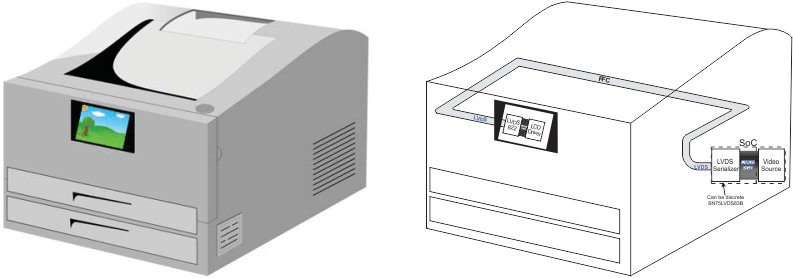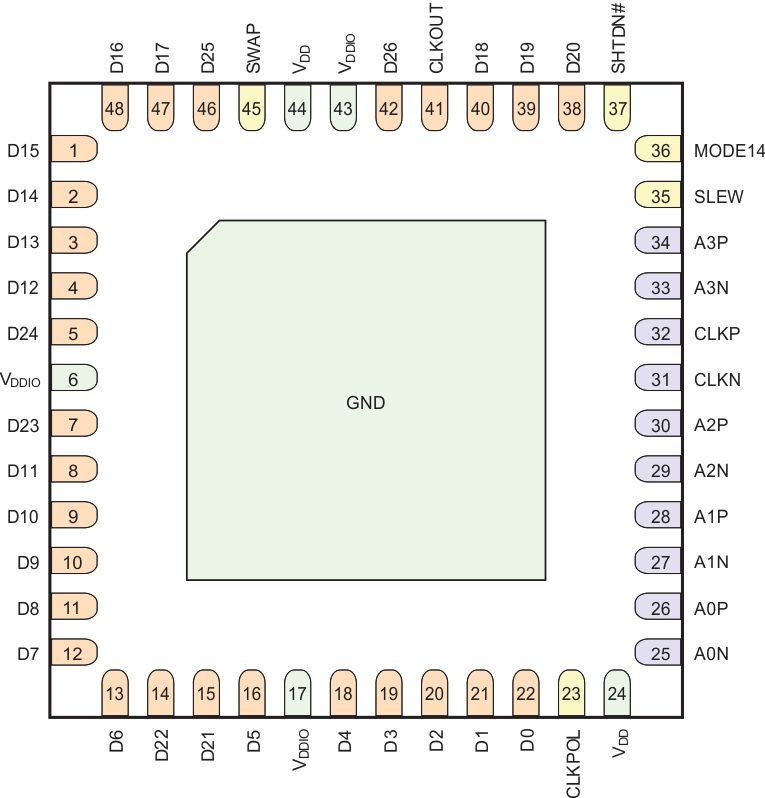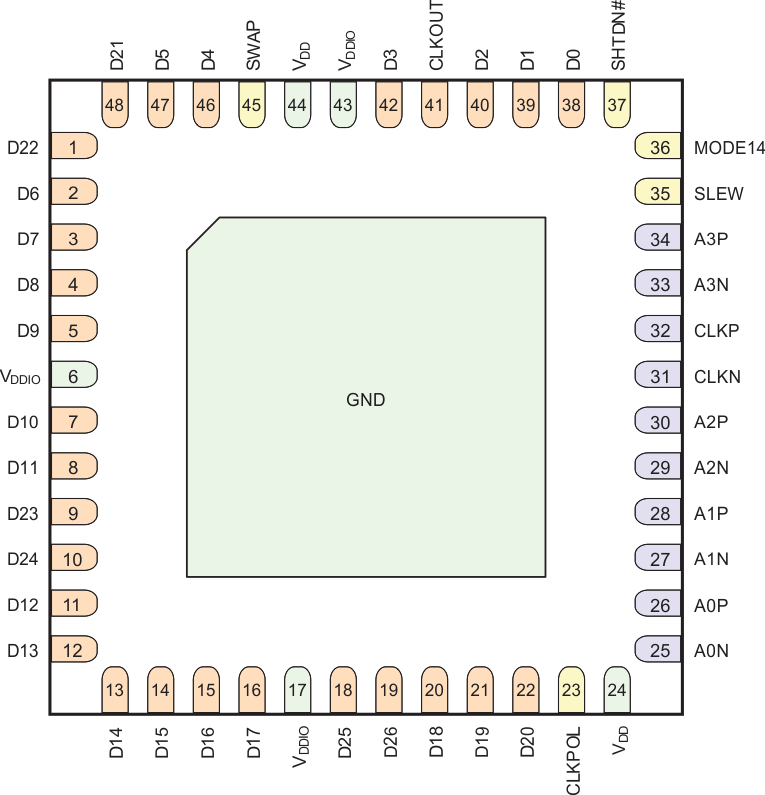-
SN65LVDS822 Flatlink™ LVDS Receiver
- 1 Features
- 2 Applications
- 3 Description
- 4 Revision History
- 5 Description (Continued)
- 6 Pin Configuration and Functions
- 7 Specifications
- 8 Parameter Measurement Information
- 9 Detailed Description
- 10Application and Implementation
- 11Power Supply Recommendations
- 12Layout
- 13Device and Documentation Support
- 14Mechanical, Packaging, and Orderable Information
- IMPORTANT NOTICE
Package Options
Mechanical Data (Package|Pins)
- RGZ|48
Thermal pad, mechanical data (Package|Pins)
- RGZ|48
Orderable Information
SN65LVDS822 Flatlink™ LVDS Receiver
1 Features
- 4:27 LVDS-to-CMOS Deserializer
- Pixel Clock Range of 4 MHz to 54 MHz, for Resolutions of 160 × 120 to 1024 × 600
- Special 2:27 Mode With 14x Sampling Allows Using Just Two Data Lanes
- Very Low EMI With 3-Way Selectable CMOS Slew Rate
- Supports Single 3.3-V Power Supply; VDDIO Allows 1.8 V to 3.3 V for Flexible Panel Support
- Clock Output is Rising or Falling Edge
- Bus-Swap Feature for Flexible PCB Layout
- Integrated Switchable Input Termination
- All Input Pins are Failsafe; ±3 kV HBM ESD Protection
- 7-mm x 7-mm 48-Pin VQFN With 0.5-mm Pitch
- Compatible With TIA/EIA-644-A Transmitters
2 Applications
- Printers
- Appliances With an LCD
- Digital Cameras
3 Description
The SN65LVDS822 is an advanced FlatLink™ low-voltage differential signal (LVDS) receiver designed on a modern CMOS process. The device has several unique features, including three selectable CMOS output slew rates, CMOS output voltage support of 1.8 V to 3.3 V, a pinout swap option, integrated differential termination (configurable), an automatic low-power mode, and deserialization modes of 4:27 and 2:27. The device is compatible with TI FlatLink™ transmitters such as the SN75LVDS83B, SN65LVDS93A, and standard industry LVDS transmitters that comply with TIA/EIA 644-A.
The SN65LVDS822 features an automatic low-power Standby Mode, activated when the LVDS clock is disabled. The device enters an even lower-power Shutdown Mode with a low voltage applied to pin SHTDN#.
The SN65LVDS822 is packaged in a 48-pin 7-mm x 7-mm Plastic Quad Flatpack No-Lead (QFN) with a 0.5-mm pin pitch, and operates through an industrial ambient temperature range of –40°C to 85°C.
Device Information(1)
| PART NUMBER | PACKAGE | BODY SIZE (NOM) |
|---|---|---|
| SN65LVDS822 | VQFN (48) | 7.00 mm x 7.00 mm |
- For all available packages, see the orderable addendum at the end of the datasheet.

4 Revision History
Changes from A Revision (October 2013) to B Revision
- Added Pin Configuration and Functions section, Handling Rating table, Feature Description section, Device Functional Modes, Application and Implementation section, Power Supply Recommendations section, Layout section, Device and Documentation Support section, and Mechanical, Packaging, and Orderable Information section Go
5 Description (Continued)
A clock frequency range of 4 MHz to 54 MHz is supported in the standard 7x mode, which is to be used with LVDS data rates of 28 Mbps to 378 Mbps. The 14x mode supports 4 MHz to 27 MHz, for LVDS data rates of 56Mbps to 378 Mbps. The LVDS clock frequency always matches the CMOS output clock frequency. DC common mode voltage is monitored on clock line for normal operation. The device is designed to support resolutions as low as 1/16th VGA (160 × 120), and as high as 1024 × 600, with 60 frames per second and 24-bit color.
The SN65LVDS822 features an automatic low-power standby mode, activated when the LVDS clock is disabled. The device enters an even lower-power shutdown mode with a low voltage applied to pin SHTDN#. In both low-power modes, all CMOS outputs drive low. All input pins have fail-safe protection that prevents damage from occurring before power supply voltages are high and stable.
The SN65LVDS822 is packaged in a 48-pin 7-mm x 7-mm Plastic Quad Flatpack No-Lead (QFN) with a 0.5-mm pin pitch, and operates through an industrial ambient temperature range of –40°C to 85°C.
6 Pin Configuration and Functions


Pin Functions
| PIN | I/O | DESCRIPTION | |
|---|---|---|---|
| NAME | NO. | ||
| A0P, A0N | 26, 25 | LVDS Input | LVDS Data Lane 0 |
| A1P, A1N | 28, 27 | LVDS Data Lane 1 | |
| A2P, A2N | 30, 29 | LVDS Data Lane 2 | |
| A3P, A3N | 34, 33 | LVDS Data Lane 3 | |
| CLKP, CLKN | 32, 31 | LVDS Clock | |
| (SWAP = L / H) | CMOS Output | Data bus output | |
| D0 | 22 / 38 | ||
| D1 | 21 / 39 | ||
| D2 | 20 / 40 | ||
| D3 | 19 / 42 | ||
| D4 | 18 / 46 | ||
| D5 | 16 / 47 | ||
| D6 | 13 / 2 | ||
| D7 | 12 / 3 | ||
| D8 | 11 / 4 | ||
| D9 | 10 / 5 | ||
| D10 | 9 / 7 | ||
| D11 | 8 / 8 | ||
| D12 | 4 / 11 | ||
| D13 | 3 / 12 | ||
| D14 | 2 / 13 | ||
| D15 | 1 / 14 | ||
| D16 | 48 / 15 | ||
| D17 | 47 / 16 | ||
| D18 | 40 / 20 | ||
| D19 | 39 / 21 | ||
| D20 | 38 / 22 | ||
| D21 | 15 / 48 | ||
| D22 | 14 / 1 | ||
| D23 | 7 / 9 | ||
| D24 | 5 / 10 | ||
| D25 | 46 / 18 | ||
| D26 | 42 / 19 | ||
| CLKOUT | 41 | Clock output for the data bus | |
| SWAP | 45 | CMOS Input | Selects the CMOS output pinout, and also controls differential input termination. |
| Low – Default pinout, RID connected | |||
| Floating – Default pinout, RID disconnected (requires external termination) | |||
| High – Swapped pinout, RID connected | |||
| MODE14 | 36 | Sets the number of LVDS serial bits per lane per clock period. | |
| Low – 7 bits (see Figure 16) | |||
| High – 14 bits; only lanes A0 and A2 are used (see Figure 17) | |||
| CLKPOL | 23 | CLKOUT polarity | |
| Low – D[26:0] is valid during the CLKOUT falling edge | |||
| Floating – Reserved; do not use | |||
| High – D[26:0] is valid during the CLKOUT rising edge | |||
| SHTDN# | 37 | Shutdown Mode; Active-Low | |
| SLEW | 35 | Sets the CMOS output slew rate | |
| Low – Slowest rise/fall time | |||
| Floating – Medium rise/fall time | |||
| High – Fastest rise/fall time | |||
| VDD | 24, 44 | Power Supply | Main power supply; 3.3 V |
| VDDIO | 6, 17, 43 | Power supply for CMOS outputs; 1.8 V to 3.3 V | |
| GND | Thermal Pad | Reference Ground | |